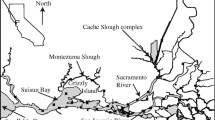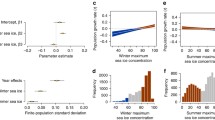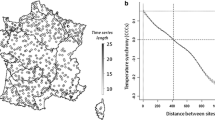Abstract
We studied the effects of inter-annual variability and serial correlation on the statistical power of monitoring schemes to detect trends in biomass of bream (Abramis brama) in Lake Veluwemeer (The Netherlands). In order to distinguish between ‘true’ system variability and sampling variability we simulated the development of the bream population, using estimates for population structure and growth, and compared the resulting inter-annual variabilities and serial correlations with those from field data. In all cases the inter-annual variability in the field data was larger than in simulated data (e.g. for total biomass of all assessed bream σ = 0.45 in field data, and σ = 0.03–0.14 in simulated data) indicating that sampling variability decreased statistical power for detecting trends. Moreover, sampling variability obscured the inter-annual dependency (and thus the serial correlation) of biomass, which was expected because in this long-lived population biomass changes are buffered by the many year classes present. We did find the expected serial correlation in our simulation results and concluded that good survey data of long-lived fish populations should show low sampling variability and considerable inter-annual serial correlation. Since serial correlation decreases the power for detecting trends, this means that even when sampling variability would be greatly reduced, the number of sampling years to detect a change of 15%·year−1 in bream populations (corresponding to a halving or doubling in a six-year period) would in most cases be more than six. This would imply that the six-year reporting periods that are required by the Water Framework Directive of the European Union are too short for the existing fish monitoring schemes.
Similar content being viewed by others
References
Backx, J. J. G. M. (1989). Waarnemingen aan de visstand in het Veluwemeer en Wolderwijd in de periode 1966–1987. Technical Report (in Dutch), Wageningen Agricultural University, Department of Fish Culture and Fisheries, Wageningen, The Netherlands.
Buijse, A. D. (1992). Dynamics and exploitation of unstable percid populations (pp. 1–168).Wageningen, The Netherlands: Wageningen Agricultural University.
Carey, J. M., & Keough, M. J. (2002). The variability of estimates of variance, and its effect on power analysis in monitoring design. Environmental Monitoring and Assessment, 74(3), 225–241.
De Nie, H. W., & Backx, J. J. G. M. (1994). Interactions between aquatic macrophytes and fish in Lake Veluwe, direct and indirect effects. In W. van Vierssen, M. Hootsmans & J. Vermaat (Eds.), Lake Veluwe, a macrophyte-dominated system under eutrophication stress (pp. 287–295). Dordrecht, The Netherlands: Kluwer.
De Wit, C. T., & Goudriaan, J. (1978). Simulation of ecological processes (pp. 1–175). Wageningen, The Netherlands: Pudoc.
European Union (2000). Directive 2000/60/EC of the European Parliament and of the Council of 23 October 2000 establishing a framework for Community action in the field of water policy. Official Journal of the European Communities, L327, 1–72.
Gerrodette, T. (1987). A power analysis for detecting trends. Ecology, 68, 1364–1372.
Gerrodette, T. (1993). ‘Program TRENDS’, User’s guide, Southwest Fisheries Science Centre, La Jolla, California.
Karr, J. R. (1981). Assessment of biotic integrity using fish communities. Fisheries, 6, 21–27.
Lourens, A. (1996). The fish community structure along a productivity gradient and the influence of year-class strength variation. MS thesis, Wageningen Agricultural University, Department of Fish Culture and Fisheries, Wageningen, The Netherlands.
Mous, P. J. (2000). Interactions between fisheries and birds in IJsselmeer, The Netherlands (pp. 1–205). Wageningen, The Netherlands: Wageningen University.
Nagelkerke, L. A. J., & van Densen, W. L. T. (2001). The utility of multivariate techniques for the analysis of fish community structures and the design of monitoring programmes. In Proceedings of ‘Monitoring Tailor-Made III: international workshop on information for sustainable water management’, September 25–28, 2000, Nunspeet, The Netherlands, Institute for Inland Water Management and Waste Water Treatment (RIZA), Lelystad, The Netherlands, pp. 323–332.
Neter, J., Kutner, M. H., Nachtsheim, C. J., & Wasserman, W. (1996). Applied linear statistical models (pp. 1–1408). Chicago: Irwin.
Pet, J. S., Machiels, M. A. M., & van Densen, W. L. T. (1996). A size-structured simulation model for evaluating management strategies in gillnet fisheries exploiting spatially differentiated populations. Ecological Modelling, 88, 195–214.
Peterman, R. M. (1990). Statistical power analysis can improve fisheries research and management. Canadian Journal Fisheries Aquatic Sciences, 47, 2–15.
Sheppard, C. R. C. (1999). How large should my sample be? Some quick guides to sample size and the power of tests. Marine Pollution Bulletin, 38, 439–447.
Sparre, P., & Venema, S. C. (1998). Introduction to tropical fish stock assessment. Part I: Manual. FAO Fisheries Technical Paper, 306.1, 1–407.
STOWA (Organisation for applied water research) (2003). Handboek visstandbemonstering: voorbereiding, bemonstering, beoordeling (in Dutch) (pp. 1–201). Utrecht, The Netherlands: STOWA.
Van Densen, W. L. T. (2001). On the perception of time trends in resource outcome. Its importance in fisheries co-management, agriculture and whaling (pp. 1–299). Enschede, The Netherlands: Twente University.
Van Vierssen, W., Hootsmans, M., & Vermaat, J. (1994). Lake Veluwe, a macrophyte-dominated system under eutrophication stress (pp. 1–375). Dordrecht, The Netherlands: Kluwer.
Verhallen, J. M., van Dijk, H. W. J., & van Densen, W. L. T. (2001). Administrative capacity to perceive long-term trends in water quality. Consequences for transboundary river management. In Proceedings of ‘Monitoring Tailor-Made III: international workshop on information for sustainable water management’, September 25–28, 2000, Nunspeet, The Netherlands, Institute for Inland Water Management and Waste Water Treatment (RIZA), Lelystad, The Netherlands, pp. 209–217.
Author information
Authors and Affiliations
Corresponding author
Rights and permissions
About this article
Cite this article
Nagelkerke, L.A.J., van Densen, W.L.T. Serial Correlation and Inter-annual Variability in Relation to the Statistical Power of Monitoring Schemes to Detect Trends in Fish Populations. Environ Monit Assess 125, 247–256 (2007). https://doi.org/10.1007/s10661-006-9516-y
Published:
Issue Date:
DOI: https://doi.org/10.1007/s10661-006-9516-y




